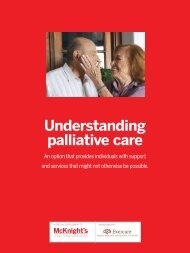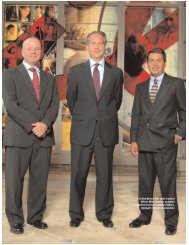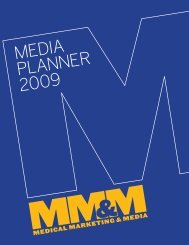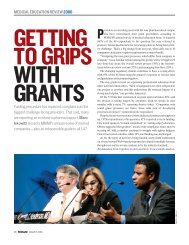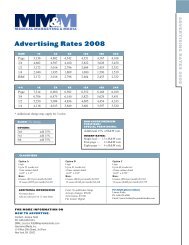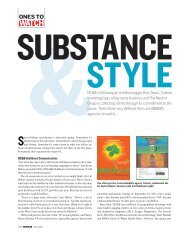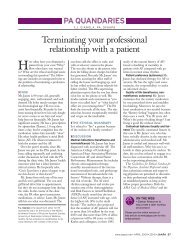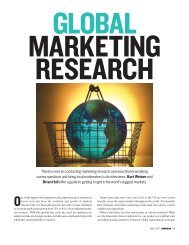Review - Haymarket Media Group
Review - Haymarket Media Group
Review - Haymarket Media Group
Create successful ePaper yourself
Turn your PDF publications into a flip-book with our unique Google optimized e-Paper software.
include those related to cell motility, invasion, proliferation,<br />
and angiogenesis. Van Laere and colleagues<br />
reported similar findings: a set of 50 discriminator<br />
genes distinguished IBC from non-IBC even after<br />
excluding estrogen receptor (ER)- or HER2-related<br />
genes. 8 When IBC-related genes are activated, tumor<br />
behavior may be more aggressive regardless of subtype,<br />
and the influence of HER2 status may be less<br />
relevant. Another possibility relates to the distribution<br />
of molecular subtypes within the Dawood study.<br />
Sixty percent of the HER2-negative tumors were also<br />
ER negative. Although progesterone receptor status<br />
was not reported, one can assume that the majority<br />
of these tumors would probably fall into the “triplenegative”<br />
subtype. Thus, triple-negative tumors<br />
were overrepresented compared with their incidence<br />
in non-IBC tumors, and a binary comparison of the<br />
prognosis of HER2-positive and HER2 negative<br />
patients would be heavily influenced by the prognosis<br />
of patients with triple-negative IBC. In this light,<br />
it would be of interest to explore the prognosis of the<br />
IBC patients according to molecular subtype (ie,<br />
luminal A, luminal B, basal-like, HER2-positive).<br />
Third, as the authors point out, the use of anthracyclines<br />
across all patients may have preferentially benefited<br />
those with HER2-positive tumors. In a pooled<br />
analysis of eight randomized trials for early breast<br />
cancer, anthracyclines were superior to nonanthracycline-containing<br />
regimens in patients with HER2positive<br />
but not HER2-negative tumors. 9 Thus, any<br />
difference in natural history between HER2-positive<br />
versus HER2-negative IBC may have been attenuated<br />
by treatment effect.<br />
With respect to OS, HER2-positive status was a<br />
favorable prognostic factor in this study, likely due to<br />
the availability of effective targeted therapy (eg,<br />
trastuzumab) for patients with HER2-positive IBC at<br />
the time of recurrence. Nevertheless, it is sobering<br />
that even in a group of women treated in a comprehensive<br />
fashion at a highly regarded cancer center<br />
that the 5-year overall survival rate for the entire<br />
cohort was only 53.1%. How can we improve? First,<br />
given the impact of trastuzumab on OS after IBC<br />
recurrence, as demonstrated by Dawood and colleagues,<br />
and the proven benefits of trastuzumab in<br />
the adjuvant setting for early breast cancer, it is likely<br />
that the current standard use of trastuzumab in the<br />
preoperative setting for patients with IBC is already<br />
having a favorable effect upon outcomes in patients<br />
with HER2-positive disease. Preliminary results<br />
from the NOAH (NeOAdjuvant Herceptin) study<br />
The challenge of IBC<br />
indicate that the addition of trastuzumab substantially<br />
improves the rate of pCR in patients with IBC<br />
compared with chemotherapy alone. 10 Given that<br />
pCR is highly correlated with RFS and OS, these<br />
results are highly encouraging. Next, there is also<br />
early evidence of efficacy from a phase II study of the<br />
oral epidermal growth factor receptor/HER2<br />
inhibitor lapatinib in patients with recurrent or<br />
anthracycline-refractory IBC in which 50% of<br />
patients experienced a clinical response. 11 Ongoing<br />
trials will further clarify whether lapatinib has a role<br />
in patients with newly diagnosed IBC.<br />
Looking beyond HER2, a number of other biologic<br />
characteristics appear to be strongly associated<br />
with both RFS and OS in patients with IBC. These<br />
include molecules related to angiogenesis (hypoxiainducible<br />
factor 1, vascular endothelial growth factor,<br />
etc), cytoskeletal organization and cell motility<br />
(eg, Rho proteins), and chemokines (CXCR4,<br />
CCR7). 7,12 Several small studies have already been<br />
completed evaluating the safety of angiogenic blockade<br />
in patients with IBC, and these studies have also<br />
demonstrated associated changes in tumor blood<br />
flow. 13,14 In the future, pharmacologic targeting of the<br />
angiogenesis and other pathways may improve outcomes<br />
in both HER2-positive and HER2-negative<br />
IBC.<br />
In summary, while Dawood and colleagues did<br />
not observe a relationship between HER2 status and<br />
RFS, the observed association between HER2 positivity<br />
and improved OS is powerful evidence that<br />
effective targeted therapy can yield meaningful<br />
improvements in outcomes from IBC. The elucidation<br />
of pathways important in the development and<br />
maintenance of the IBC phenotype and the development<br />
of drugs to target these pathways continue to<br />
move forward. However, because of the relative rarity<br />
of IBC, the pace of further advances in the field<br />
will depend not only on the pipeline of new targeted<br />
drugs but upon a concerted effort to sustain multidisciplinary<br />
and cross-institutional collaborations. ✦<br />
References<br />
1. Levine PH, Veneroso C. The epidemiology of inflammatory<br />
breast cancer. Semin Oncol. 2008;35:11-16.<br />
2. Gonzalez-Angulo AM, Hennessy BT, Broglio K, et al. Trends<br />
for inflammatory breast cancer: is survival improving?<br />
Oncologist. 2007;12:904-912.<br />
3. Slamon DJ, Clark GM, Wong SG, et al. Human breast cancer:<br />
correlation of relapse and survival with amplification of the<br />
HER-2/neu oncogene. Science. 1987;235:177-182.<br />
4. Cabioglu N, Gong Y, Islam R, et al. Expression of growth factor<br />
November 2008 • Vol 7 • Supplement 5 21



